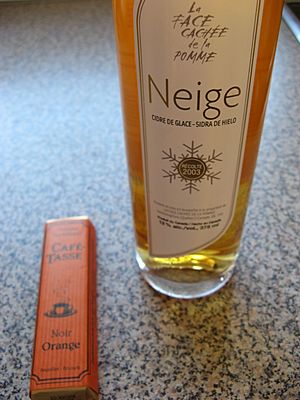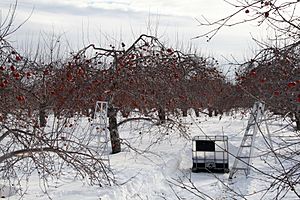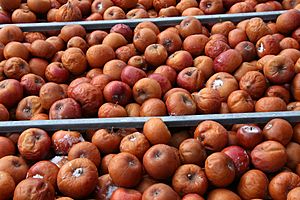Ice cider facts for kids
Ice cider is a special drink made from frozen apples. It's like ice wine, but for apples! In French, it's called cidre de glace. In the United States, you might see it sold as "ice apple wine." This unique drink is made by fermenting (a process where sugar turns into alcohol) the juice from apples that have been naturally frozen.
Ice cider was first created in Quebec, Canada. This region is perfect because it gets very cold, which helps the apples freeze. Now, people also make it in other places that have cold winters and good apple orchards.
History of Ice Cider
Ice cider was invented in Quebec by a winemaker named Christian Barthomeuf. He is often called the "father of ice cider." In 1989, he got the idea from ice wines made in Germany. Quebec's climate is much better for growing apples than grapes, so he thought, "Why not try the same freezing method with apples?"
In 1994, Christian Barthomeuf worked with Francois Pouliot to make ice cider in larger amounts. They did this at a place called La Face Cachée de la Pomme, which is a cidery (a place where cider is made).
The very first bottle of ice cider sold officially appeared in 1999. It was sold at a government store in Quebec called the Société des alcools du Québec (SAQ). This was also the first year authorities allowed the name "ice cider." They had been worried people might confuse it with regular cider. Today, there are more than 60 companies making ice cider!
This special drink has inspired producers in other places too. You can now find ice cider being made in Western Canada, Europe, and the United States. It first spread to nearby areas like Ontario in Canada and Vermont in the U.S. In 2008, the Quebec government made rules about how ice cider must be produced. Then, in 2014, Quebec ice cider got a special label called an IGP. This label means it comes from a specific place and is made in a certain way, following international rules.
Quebec's cold winters are perfect for freezing apples naturally. However, making ice cider needs a lot of apples. You need about four to five times more apples than for regular cider! Because of the special climate needed, ice cider production has grown slowly. But it is now starting to be made all over the world. Vermont in the U.S. is one place where it is becoming very popular. Ice cider has even won many awards! In 2007, Christian Barthomeuf won a top prize from a group in Spain for inventing ice cider. La Face Cachée de la Pomme also won for helping to develop and sell it around the world.
How Ice Cider is Made
Ice cider is made by concentrating the natural sugars in apples using cold temperatures. There are two main ways to do this: cryoconcentration and cryoextraction. The most common apples used are McIntosh, Cortland, Empire, and Spartan. Some new types of apples have even been grown just for ice cider. This is because one method, cryoextraction, needs the apples to stay on the trees longer than usual.
The cryoconcentration method is a bit like how some Indigenous Canadians learned to concentrate maple syrup using the cold. They would let it freeze, then break off a piece that was more concentrated. The cryoextraction method is directly inspired by how ice wine is made.
How to Enjoy Ice Cider
Ice cider is usually served in small amounts. People often drink it as an apéritif before a meal. It also tastes great with a cheese plate or a dessert after a meal.





